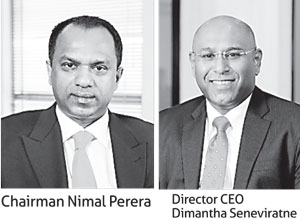Reply To:
Name - Reply Comment
Pan Asia Bank recorded an impressive 265 percent growth in profit after tax (PAT) for the financial year ended December 31, 2014 to post Rs.415.2 million on the back of strong core-banking performance, non-fund-based income and efficient cost management.
The pre-tax profit too grew by three folds to Rs.538.4 million. These results were achieved in spite of substantial provision for impairment on loans and other losses of Rs.815 million.

The bank’s December quarter (4Q’14) results too followed suit with a profit of Rs.138.1 million for the quarter setting the stage for a sustainable growth momentum in the years ahead.
Core banking drives performance
The bank’s top line measured by the net interest income (NII) rose by a commendable 350 percent year-on-year (YoY) in the 4Q’14 to Rs.850.1 million and 31 percent for the whole year to Rs.2.7 billion due to significantly higher growth in loan book and prudent asset and liability management.
Loans and receivables has grown by 34 percent to Rs.63.3 billion which is by far the highest in the industry amid lacklustre demand for credit in the economy as the private credit grew by only 9 percent in 2014.
The bank has successfully managed the narrowing banking sector margins by increasing its net interest margin (NIM) by 13 percent to 3.82 percent as the drop in the bank’s cost of deposits outweighed the drop in loan yields in the lower interest environment.
Timely pricing of products and timely fund management in to more remunerative areas had played a major role in improving the NIM in 2014.
Further, the bank has made conscious efforts on improving the high-yielding asset classes in its advances mix while identifying market niches where the bank could command a premium. This was amply supported by the bank’s innovative product portfolio.
The bank’s persistent push for attracting low-cost funds saw Pan Asia Bank significantly improving its CASA ratio to 30.5 percent by end-December 2014 from 19.3 percent a year ago and the bank is gradually catching up with the industry CASA averaging around 39.5 percent.
Non-fund-based income, a growing source of income
The bank has made a concerted effort to improve its fee and commission income (net), which has grown by 52 percent YoY in 4Q’14 to Rs.197.1 million and by 17 percent for the FY 2014 to Rs.628.6 million.
As a result, the total operating income for the 4Q’14 rose by 144 percent YoY to Rs.1.2 billion and by 27 percent for the FY 2014 to Rs.4.0 billion.
Improving efficiency
On the other hand, the operating costs during the 4Q’14 rose by a moderate 14 percent YoY to Rs.648.2 million and by 12 percent for the FY 2014 to Rs.2.5 billion in part due to the increase in the general price levels in the economy and the costs related to the implementation of the new core-banking system.
In this backdrop, the cost to income ratio has improved from 69 percent from 61 percent a year ago.
One reason for the bank’s relatively high cost to income ratio is the investments related to rapid branch expansion in the recent past. However, the increase in business volumes, the bank will be able to contain the ratio further when the already deployed resources start to operate at their optimum capacity.
Balance sheet growth with good asset quality
Amid market challenges the bank managed to increase its asset base by 23 percent in 2014 to Rs.79.6 billion supported primarily through the advances growth.
Meanwhile, the deposits grew by 21 percent to Rs.64.9 billion during a challenging period where the customers had low appetite for bank deposits in a low interest rate environment prevailed.
The gross non-performing loan (NPL) ratio has further improved to 5.73 percent from 8.01 percent a year ago signifying the improving quality of the bank’s asset portfolio. The net non-performing loan ratio too followed suit as it improved to 3.78 percent from 6.49 percent.
The bank also increased its impairment cover ratio in FY 2014 which reflects the higher loan loss absorption capability to withstand shocks.
Stability through capitalisation
Pan Asia Bank’s capitalisation levels strengthened as its core capital (Tier I) and capital base (Tier II) stood above Rs.4.4 billion and Rs.6.9 billion with capital adequacy ratios of 8.97 percent and 14.19 percent, respectively. This is above the minimum regulatory requirements of 5 percent and 10 percent.
The bank also issued a rated, unsecured, subordinated, redeemable debenture to raise Rs.3 billion which was well received by the market in October 2014 as it was oversubscribed on the opening day itself.
Improving shareholder value
Amid pressurising margins Pan Asia Bank improved its return to its shareholders (return on equity) to 9.81 percent from 2.89 percent from a year ago.
The earnings per share increased to Rs.1.41 from just Rs.0.39 a year ago whilst the market price per share rose by 67 percent to Rs.25.90 during 2014.
Pan Asia Bank in 2015 celebrates 20 years of successful operations as a licensed commercial bank in Sri Lanka and in 2014 the bank received the coveted ‘Fastest Growing Commercial Bank in Sri Lanka - 2014’ award from the United Kingdom’s Global Banking and Finance Review magazine.